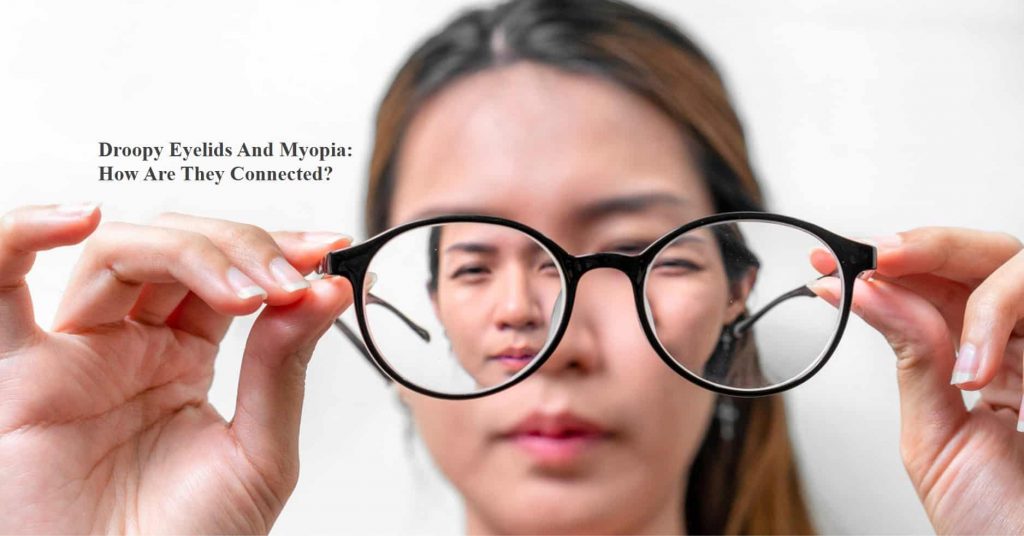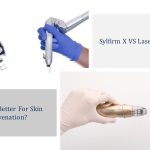Ptosis is a unique disorder of eyelids, which is often associated with conditions other than droopy eyelids, like myopia. Research has shown that there is a high occurrence rate of myopia in individuals with droopy eyelids (15%) compared to the normal (4.4%), particularly in children of less than eight years of age.
The severity of myopia found in the unilateral ptotic eye is mild to moderate, with no severe cases found. Prolonged congenital ptosis impairs the formation of the image on the retina, leading to myopia – the frequency of which increases with growing age.
In contrast to the previous studies, it has been lately found that all cases of myopia with congenital ptosis or neonatal eyelid-closure are of mild or medium degree.
Alongside myopia, droopy eyelid also causes a myriad of eye conditions and discomforts, which include:
- Astigmatism – vision disturbance due to irregularity in the shape of the cornea of the eye.
- Eye discomfort – Dry or watery eyes.
- Migraine headache – caused by excessive strain on the forehead muscle.
- Stiff neck – occurred by persistent backward tilting of the head for a clear vision.
This article will discuss the causes of ptosis, its symptoms, diagnosis, and treatment options.
How Does One Get Droopy Eyelids?
The following are the causes of a ptotic eye.
Congenital
Congenital ptosis is a type of droopy eyelids that is present at birth. While it occurs in rare cases, it can lead to other problems if it remains untreated. Even though it develops as a benign condition, it can cause cosmetic, functional, and psychological issues in children. This type of ptosis can affect one or both sides of the eye. Congenital ptosis occurs as a presentation of myogenic ptosis, Horner’s syndrome, third cranial nerve palsy, and Marcus Gunn jaw-winking syndrome.
Acquired
Acquired ptosis can occur because of an underlying medical problem. There are various subtypes of acquired ptosis, which include:
Myogenic Ptosis
This typically occurs due to dysfunction of the levator muscle of the eyelid, preventing it from rising to its correct level and form when the eye is opened. Myogenic ptosis occurs secondary to certain diseases, such as myasthenia gravis and myotonic dystrophy.
Aponeurotic Ptosis
Usually found in older adults, aponeurotic ptosis occurs due to loss of tone in levator muscle and its aponeurosis as a result of overstretching with age. Thus, the muscle then droops downwards due to gravity.
Mechanical Ptosis
This type is concerned with the weight of the eyelid. The heavy eyelid cannot be raised by the little mechanical forces from the levator muscle. Eyelids can become heavy due to orbital-fat prolapse, edema, or inflammation of the eyelid or eyelid tumors.
Neurogenic Ptosis
This type can be caused by central nervous damage that leads to sympathetic or oculomotor nerve damage.
Traumatic Ptosis
Trauma or injury can cause disinsertion of levator muscle leading to traumatic ptosis.
Signs And Symptoms Of Droopy Eyelid
The major symptom of ptosis is drooping of the upper eyelid. However, there are some other significant signs and symptoms too:
- Limited eye movement
- Difficulty in closing the eyelids (e.g., blinking)
- Reduced visual field
- Tilting of the head backward to have a proper view
- Raising of the eyebrows to open eyes more by lifting eyelids.
- Aching or fatigue around the eyebrows and eyes
- The smaller appearance of the eyes
- Difficulty looking upwards
- Poor eyelid function leading to dryness and irritation in the eyes
- Higher eyelid crease on the affected side
 How Is It Diagnosed?
How Is It Diagnosed?
In some individuals, a physical examination is enough as droopy eyelids are very obvious, and no further diagnostic tests are needed. However, in cases in which an underlying medical condition is suspected, the physician might suggest further tests.
Your photos might be taken for future comparison of droopy eyelid treatment outcomes. Other tests that doctors may suggest to some people include a slit-lamp examination to check different eye structures, visual field testing to measure peripheral vision, and the Tensilon test – if myasthenia gravis is the suspected cause of ptosis.
For congenital ptosis, your clinician may discern ptosis in a newborn baby. At other times, parents might notice a child having droopy eyelids and take him to a healthcare provider for a clinical examination.
The physician will inquire about the child’s medical history and carry out a physical exam. If there is a need, the child may be referred to an ophthalmologist for a specialized eye exam or a neurologist for an in-depth nervous check-up.
How Is Ptosis Treated?
The type of droopy eyelid treatment your child gets depends on:
- Cause of ptosis and its severity
- Your child’s age, symptoms, and medical history
Doctors use both non-surgical and surgical interventions for droopy eyelids. Surgery is done to tighten up the muscles that lift the eyelid. Eye drops, patching techniques, or specialized glasses can also be used to strengthen the weaker eye.
Non-Surgical Droopy Eyelid Treatment
Non-surgical ptosis treatment includes medications and eyelid crutch technique. These are as follows:
1. Medication
Medications are given to patients who have an underlying disease as a cause of ptosis. The pre-existing condition is treated first to eliminate the cause. For example, oral steroids are given to patients who are diagnosed with myasthenia gravis.
 2. Eye Crutch and Applicable to Which Condition
2. Eye Crutch and Applicable to Which Condition
Spectacles-like frames, called the eyelid crutch, are used to lift the eyelid. This is a non-surgical method but has temporary results only as long as the eyewear is worn. Eye crutches include wire loops attached to eyeglasses to grip the eyelids up.
Surgical Droopy Eyelid Treatment
Ptosis surgery, also called blepharoplasty, is the main treatment for long-term results. This involves various procedures such as Muller resection, levator resection, frontalis sling, and Fasanella-Servat.
In mild to moderate cases, the surgeon will shorten and tighten the levator muscle of the eyelid or repair the levator aponeurosis. In severe cases, the surgeon attaches the eyelid muscle to the forehead and eyebrow muscles for an added strength. The surgical techniques are broadly categorized into non-incisional and incisional techniques.
1. Non-Incisional Droopy Eyelid Surgery
During this procedure, muscle length is decreased by tying part of the eyelid muscle with the help of a suture. The tightening effect created by a decrease in the muscle’s length enables the eyelids to rise higher when eyes are opened.
The best candidates for this technique are individuals with mild droopy eyelids. Its procedure time is 40 – 60 minutes and is done under local anesthesia or light sedation. The recovery period is seven days, and the stitches are removed seven days after the procedure.
2. Incisional Droopy Eyelid Surgery
For severe cases, incisional surgery is needed. In this technique, the overstretched eyelid muscle is trimmed and pinned upwards, resulting in a higher lift of the eyelids with opening the eyes. Excess skin and fat are also eliminated, and double eyelids are redefined.
It is done in candidates suffering from moderate to severe droopy eyelids. The procedure typically takes 60 – 90 minutes to complete and is done under light sedation. The recovery period is 10 – 14 days, and stitches are removed after seven days of the procedure.
Things to Consider for Droopy Eyelid Treatment
For Children
There is some difference in the droopy eyelid treatment for children and adults. For children, the clinician will consider the age of the child, the height of the affected eyelid, the movement range of the affected eye, whether the condition affects one or both eyes, and the strength of the eyelid muscle.
In some kids, ptosis is accompanied by a lazy eye. In such cases, special eyeglasses or an eye patch might be considered. However, in others, eye drops can improve the condition. Whatever treatment is selected for your child, the goal is to strengthen the weaker eye.
For Adults
As for adults, the type of treatment chosen mostly depends upon the severity of their conditions and desired outcomes. From ptosis crutch, sling operation, or any other surgical or non-surgical method can be chosen. In sling operation, the excessively weak levator muscle is attached to the forehead muscle for reinforced strength and power to lift the affected eyelid.
As for ptosis crutch, the eyewear can be custom made for the patient to hold their eyelid in place so that it no longer droops. The crutches on metal frames are the best as they can be attached to almost all types of eyeglass frames.
Seek Early Treatment For Droopy Eyelids
Whether you have unilateral or bilateral ptosis, prompt treatment is required to prevent future complications. Make sure to choose a clinical setting where a board-certified plastic surgeon performs the procedure for the best results.
About Dream Aesthetics and Plastic Surgery
Bespoke surgical for cosmetic or medical reasons is what Dream covers to bring out the beauty in every individual. Going beyond the aesthetics and working on physical anomalies are what we value the most in leading our patients to cherish self-improvement and confident lifestyles.
Derived from Associate Professor Vincent Yeow’s long-standing experience performing plastic surgery in Singapore, our treatment plans deliver physical remodelling in our patients’ favour. One of the notable remodellings is droopy eyelid correction. The ptosis surgery used for treatment eventually fixes drooping eyelids, improves vision and enhances appearance.
Most importantly, as a trustworthy plastic surgery and aesthetic clinic, we treasure positive and natural outcomes for each individual. We will ensure to deliver the beauty refinement of your dream without compromising your safety and privacy.







